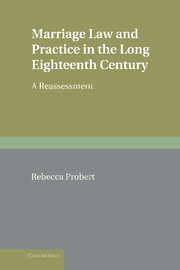Book contents
- Frontmatter
- Contents
- Preface
- 1 Introduction
- 2 The misunderstood contract per verba de praesenti
- 3 The myths of ‘informal’ and ‘common-law’ marriage
- 4 The little-considered marriage practices of non-Anglicans
- 5 The unacknowledged regularity of clandestine marriages
- 6 The eventual passage and actual terms of the 1753 Act
- 7 The unappreciated success of the 1753 Act
- 8 The unexplored judicial interpretation of the 1753 Act
- 9 The overlooked response of non-Anglicans
- 10 Conclusion
- Index
- References
8 - The unexplored judicial interpretation of the 1753 Act
Published online by Cambridge University Press: 10 February 2010
- Frontmatter
- Contents
- Preface
- 1 Introduction
- 2 The misunderstood contract per verba de praesenti
- 3 The myths of ‘informal’ and ‘common-law’ marriage
- 4 The little-considered marriage practices of non-Anglicans
- 5 The unacknowledged regularity of clandestine marriages
- 6 The eventual passage and actual terms of the 1753 Act
- 7 The unappreciated success of the 1753 Act
- 8 The unexplored judicial interpretation of the 1753 Act
- 9 The overlooked response of non-Anglicans
- 10 Conclusion
- Index
- References
Summary
The prevalent view among modern commentators is that the Act was interpreted extremely harshly. Stone, for example, has claimed that ‘the slightest mistake, however accidental or trivial’ might invalidate a marriage, even if this was simply a matter of misstating the age of the parties or omitting their middle name, and similar views have been advanced by other commentators. Yet such a synthesis of the case law is misleading: it is true that there were cases in which marriages were annulled on the basis that one party's middle name had been omitted from the banns, and that there were cases in which marriages were annulled because of an (accidental) failure to comply with the law, but there are no reported cases in which a marriage was annulled because of an accidental omission of one party's middle name. Some commentators have based their indictment of the entire Act on one single case – and when one finds the same case being cited by a number of commentators one does begin to wonder whether there are any other examples. Moreover, reporting the bare facts of a case may not indicate why that particular marriage was annulled: any decision, shorn of its context, may appear harsh or inexplicable.
In order to understand exactly when and why a marriage might be annulled on the basis of the parties' failure to comply with the required formalities, we need to pay close attention not only to the reasoning of the case, but also its context.
- Type
- Chapter
- Information
- Marriage Law and Practice in the Long Eighteenth CenturyA Reassessment, pp. 284 - 313Publisher: Cambridge University PressPrint publication year: 2009



